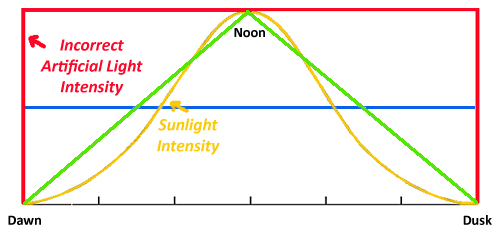Light is a basic need of all plants, but it is a subject that is often misunderstood.
For example, when we hear light level recommendations for a particular plant, it is often “low-“, “medium-“, or “high-light”, but what exactly does that mean? Unfortunately, depending on the source of the information, that can vary all over the map.
Generally, I like to think of things in terms of degree of shade, and even then it’s not particularly specific. Let’s start at the extremes – to me, a “low-light” plant is one that does best in indirect light only, never seeing any direct sunlight. I would put most phalaenopsis in that category, for example. At the other end is “high light”, which basically connotes full sun. I have found Rhyncholaelia digbyana to be a plant that does best under that light level, as do most other plants with terete leaves. Then there is that large area in-between.
When deciding the relative degree of light a plant may like, it pays to consider their conditions in nature. Paphiopedilums, for example, usually live in the leaf litter on a forest floor and have a lot of cover over them, allowing only a few shafts of sunlight to penetrate. Cattleyas, on the other hand, can be higher up in the canopy, where they will have less cover. As a result, they tend to get more light, with a moderate degree of dappling.
Folks who grow under lights, or are keen to check levels with a light meter, where lumens and foot-candles are the controlling factors, can also be led astray by the guidance. I’ll use a hypothetical scenario do demonstrate:
You just moved into a dark apartment and decide to grow your orchids under lights. In your reference books, the particular plants come with a recommendation of “2500- to 3000 foot candles”. You do some online research and discover that a 2-bulb, 48″ T5 HO fluorescent fixture might just be what you need. Starting out at about 10,000 lumens, you’ll be able to elevate the fixture about 9″ to 12″ above the plants and get about 3000 foot-candles of light intensity. Fourteen hours on and ten hours off should do it, right? Actually, you’ll be overdoing it at that intensity.
It pays to consider two things about the interaction between plants and light: First, the “2500- to 3000 foot candles” recommendation as the highest light level the plant can comfortably tolerate. The intensity of natural sunlight goes through a “bell curve”, starting at zero at dawn, reaching a maximum at noon, and returning to zero at dusk (the yellow line in the graph). Second, the absorption of light – photons, to be precise – is cumulative. Within reason, a relatively short period of brighter light is roughly equivalent to a longer period of dimmer light.
The area of the “bell curve” of natural sunlight – the “volume” of photons, if you will – can be estimated by superimposing a triangle on it (green). As the area of a triangle is one-half its height multiplied by its base, that suggests that, under lights, our “2500- to 3000 foot-candle plants would actually do much better under twelve to fourteen hours of continuous 1300- to 1500 foot-candles (blue).

Also keep in mind that plants can be fairly adaptable about light levels, and that “more” is not necessarily “better”. I have seen vandaceous plants adapt quite well to the lower light levels of windowsill growing, while phalaenopsis grown in too much light simply refuse to bloom at all!
Ray Barkalow has been growing orchids for over 45 years, and owns First Rays, which offers horticultural products to the hobby grower. You can visit his website at FirstRays.com.
Related Articles & Free Email Newsletter Sign Up
How to Choose the Best Orchid Container
How to Prepare Semi-Hydroponics Media for Use with Orchids




Comment here